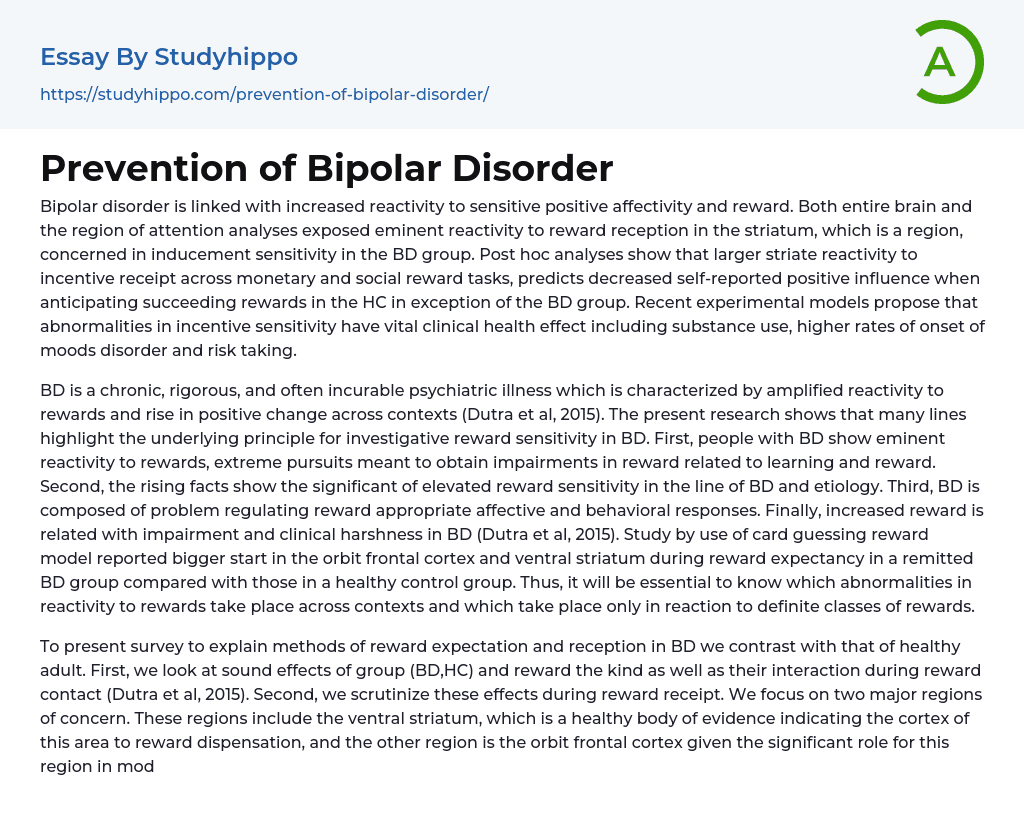Bipolar disorder is associated with increased sensitivity to positive emotions and rewards. Both whole brain and attention region analyses revealed a strong response to receiving rewards in the striatum, a region involved in experiencing pleasure in individuals with bipolar disorder (BD). Further analysis showed that individuals with BD exhibit a greater response in the striatum to receiving rewards in both monetary and social contexts, which predicts a decrease in self-reported positive feelings when anticipating future rewards compared to individuals without BD. Recent experimental models suggest that abnormalities in sensitivity to rewards have important clinical implications, including substance use, higher rates of mood disorder onset, and risk-taking behavior. BD is a chronic psychiatric illness characterized by heightened reactivity to rewards and an increase in positive emotions across various situations (Dutra et al, 2015).
The current study demonstrates that there
...are several key findings concerning investigative reward sensitivity in individuals with BD. Firstly, individuals with BD exhibit heightened responsiveness to rewards and engage in extreme efforts to obtain reward-related outcomes, which can impair learning and reward processes. Secondly, increasing evidence supports the importance of elevated reward sensitivity in the development and causes of BD. Lastly, BD is characterized by difficulties in regulating appropriate affective and behavioral responses to rewards.
In a study by Dutra et al (2015), it was discovered that individuals with bipolar disorder (BD) experience impairment and more severe symptoms when exposed to increased rewards. The study utilized a card guessing reward model and observed that individuals with remitted BD displayed higher levels of activation in the orbitofrontal cortex and ventral striatum while anticipating rewards, compared to a healthy control group. Understanding the different abnormalities in rewar
response in various contexts and for specific types of rewards is crucial. To investigate how BD affects reward expectation and reception, we compare them to those of healthy adults, examining the effects of group (BD, HC) and the type of reward, as well as their interaction during reward processing (Dutra et al, 2015).
The authors of this paragraph examine the impact of receiving rewards on two key areas: the ventral striatum and the orbit frontal cortex (OFC). The ventral striatum is responsible for distributing rewards, while the OFC helps regulate reactions to punishment and reward. By analyzing social incentive delay and monetary incentive delay tasks, the authors ensured that their psychometric properties were comparable, leading to consistent emotional and behavioral responses similar to previous studies using the monetary incentive delay. Regarding emotions, the authors discovered that reward trials received more positive ratings compared to neutral trials.
Additionally, there is a significant consequence of the task, which demonstrates more positive results on MID (Dutra et al, 2015). When evaluating the relationship between behavioral and neutral aspects, the SID task provides an opportunity for future neuroimaging studies to expand the examination of reward distribution beyond monetary rewards, including cost-effective and valid social rewards. Furthermore, the discovery of elevated visual cortex activity in response to both social and monetary rewards in individuals with BD provides evidence of a domain-general progression that may be linked to clinical outcomes related to increased reward sensitivity, even among individuals in remission with BD. These findings align with models of BD that highlight persistent elevation of positive affect across different contexts as a central characteristic. Additionally, this finding supports theoretical models that emphasize the
role of reward response as a crucial process associated with BD.
Thirdly, the discovery that striatal reactivity to rewards is predictive of reduced anticipatory positive impact in healthy individuals, but not in BD, supports theories of impaired or slowed appetitive behaviors in BD. The results of the study showed that the novel SID task effectively induced increased positive emotions during the anticipation and receipt of socially rewarding positive feedback (Dutra et al., 2015). Analyzing potential group differences in neural reactivity to rewards revealed a significant finding in the BD group, indicating heightened striatal reactivity to both monetary and social rewards. Lastly, future research should examine whether striatal reactivity to rewards can predict changes in symptoms or behaviors, consistent with the effects of rewarding life events among individuals with BD.
References
- Dutra, S. J., Cunningham, W. A., Kober, H., & Gruber, J. (2015). Elevated striatal reactivity across monetary and social rewards in bipolar I disorder. Journal of abnormal psychology, 124(4), 890.
- Adhd essays
- Antisocial Personality Disorder essays
- Anxiety essays
- Bipolar Disorder essays
- Depression essays
- Depression And Anxiety essays
- Dyslexia essays
- Learning Disability essays
- Major Depressive Disorder essays
- Mental Disorder essays
- Mental Illness essays
- Psychosis essays
- Schizophrenia essays
- Stress essays
- Suicide essays
- Apology essays
- Character Traits essays
- Compassion essays
- Expressive essays
- Perseverance essays




